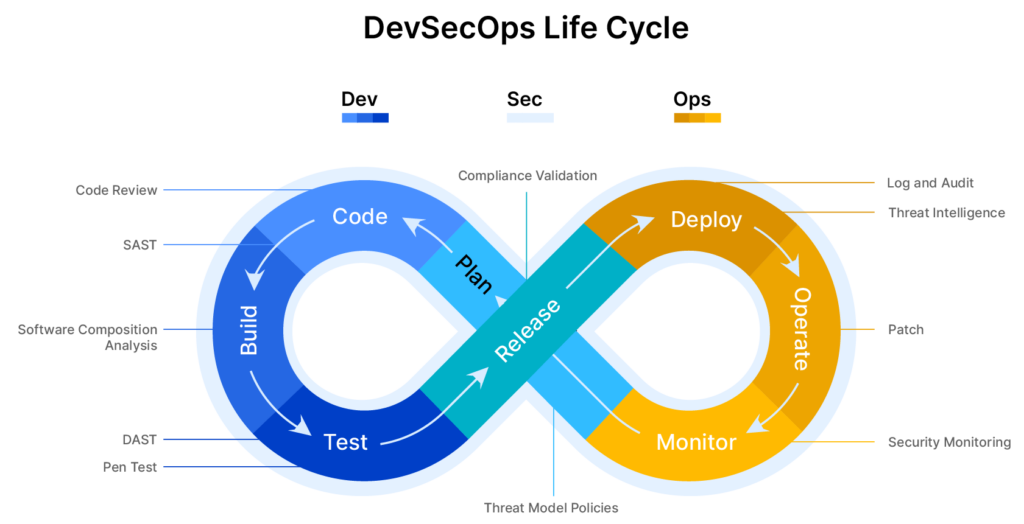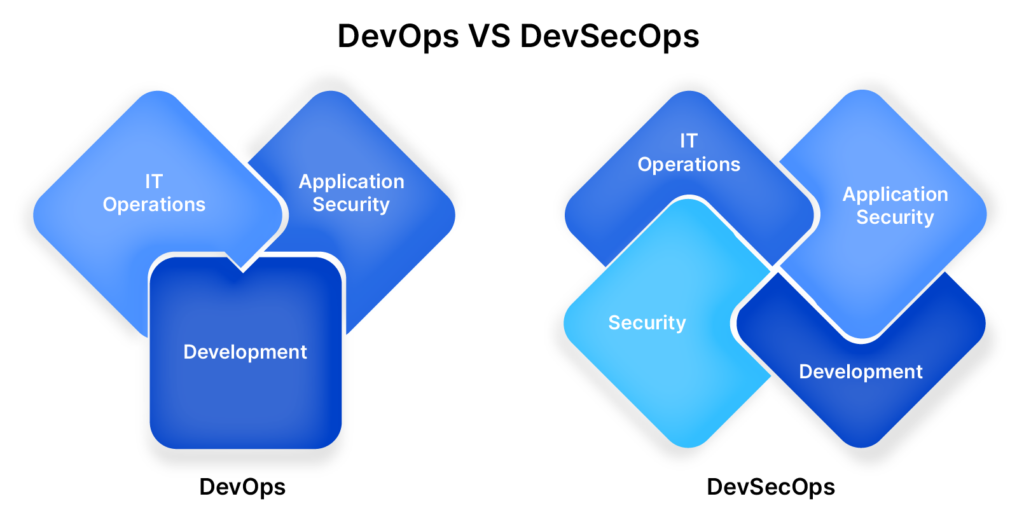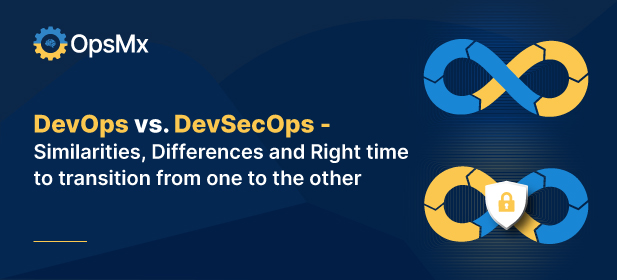DevOps and DevSecOps are still relatively new concepts in the field of software engineering. While both are modern day evolution of traditional agile/ SDLC practices, knowing which particular philosophy to embrace depends upon your organization’s goals/ objectives. In this blog, I’ll be decoding the differences between DevOps vs. DevSecOps so that you can decide for yourself.
Table of Contents:
- Evolution of software development processes over the years
- What is DevOps – principles, benefits & shortcomings
- What is DevSecOps – principles & benefits
- Comparing DevOps vs. DevSecOps – similarities & differences
- When to transition from DevOps to DevSecOps
- Conclusion – How OpsMx can help you with the transition
Evolution of Software Development processes over the years
In order to truly understand the purpose of DevOps and DevSecOps, we need to understand the shortcomings of yesteryear software development processes. While Agile and Waterfall methodologies greatly improved the speed of development and provisioning of software, they never focussed on incorporating adequate customer feedback. Oftentimes there was a mismatch between customer expectations and the end product delivered. An offshoot of this was unstable/ unreliable deployments.
The first major evolution was the introduction of Agile. While Agile improved Waterfall model’s end product by delivering software in quick sprints and frequent releases, it lacked end user empathy. In order to ensure that the software being developed is relevant to customer needs, as well as to ensure that the release is reliable/ stable in production, the software development process naturally evolved once again into what is now known as DevOps.
What is DevOps?
DevOps is a modern day software development process where the priority is laser focused on two aspects:
- Fast development (or improved development & release velocity)
- Stable deployment/ release (or improved software quality)
DevOps, in short for ‘Development’ and ‘Operations’ aims to bring these two teams together for better collaboration and greater accountability of the software that gets shipped. DevOps also places a very high emphasis on ‘automation’ in order to reduce toil and minimize human errors. For the reasons mentioned above, DevOps requires more of a culture change within the company rather than just a tooling/ process change within the engineering team.
Principles of DevOps
1. Collaboration
By bringing the two teams – ‘Dev’ and ‘Ops’ together, DevOps processes advocates for better communication in order to improve the speed and efficiency of software development by streamlining the process from start to finish. This was a welcome move because the former software development processes of the time had different teams working in silos. The development team would build the complete application and hand over the final codebase to the operations team for release at the very end. And any back-and-forth of activities in the process would be associated with friction and chaos alongside unnecessary bottlenecks.
2. Accountability
Related to the previous point, working in silos was leading to a lack of ownership of the end product. Any issue/ bug arising in the code would be passed off as ‘worked well in my system, so it is not my fault’. By making ‘Dev’ and ‘Ops’ teams more accountable for the software they ship, DevOps ensures that the code is behaving as expected not only in the developer’s environment where the code was written, but also in the production environment where the code finally gets deployed. Thus, establishing shared responsibility of the shipped code between the two teams, leads to more stable deployments and less production issues.
3. Automation
DevOps places a strong emphasis on replacing manual human effort (toil) with automated tools and processes. For eg., an activity such as ‘infrastructure provisioning’ is mundane, time consuming and error prone. By leveraging automated tools and processes to perform the same steps DevOps not only minimizes manual toil, but it also frees up precious man hours which can instead be used for high-value tasks.
4. Monitoring
DevOps introduced us to the concept of continuous monitoring and optimization. The basis for this was the need to incorporate quick feedback loops and make iterative improvements to the software. Let’s face it, no software code can ever be bug-free, but they can always be improved upon quickly and iteratively in short sprints. Thus, implementing monitoring tools to provide real-time feedback on application and infrastructure performance became a core tenet of DevOps. This not only enables quick detection and resolution of issues, but also improves the overall system reliability and customer satisfaction.
Now that you’ve understood the principles of DevOps, let me quickly summarize the benefits of DevOps.
Benefits of DevOps
- Faster Time-to-Market
- Improved Quality and Reliability
- Enhanced Efficiency and Developer Productivity
- Scalability and Flexibility
- Reduced Time and Cost of Development
- Increased Deployment Frequency
- Better Alignment with Business Objectives
- Continuous Learning and Improvement
The details above would’ve given you a fair idea of the advantages of adopting the DevOps process. But like everything else, DevOps is not fool-proof. Let me address the shortcomings and how it impacted the evolution of software development processes.
Shortcomings of DevOps
While DevOps was/ is suitable for most of the organizations, some aspects such as tool sprawl, security and compliances often get overlooked or are not prioritized enough in the process. This however can be non-negotiable, especially for enterprises.
1. Security & Compliances
In highly-regulated industries, staying compliant to industry or organization-specific policies is mandatory. Disobedience could potentially lead to heavy fines/ penalties. In certain industries such as Banking and Healthcare, non-adherence could even lead to revocation/ termination of license. Another factor is that when an enterprise is large and complex (with distributed teams), then enforcing policies or standardizing security controls becomes difficult.
This leads to siloed security teams. Bringing them into the picture towards the time of deployment only leads to disagreements and security bottlenecks. For eg., if a compromised package is found in the codebase, or if proper coding standards are not followed then the release would have to be blocked and fixed first and foremost.
2. Tool sprawl
On the one hand, automation eliminates manual toil, but at the same time it introduces one too many tools in the workflow. An already overcrowded tool set in the tech stack will only get bigger and longer with the adoption of DevOps. For eg., you could have one or more tools for version control, configuration management, continuous integration, continuous deployment, monitoring, ticketing, incident response, and so many more categories.
In fact, different distributed teams working within a large enterprise could all end up using a different tool for similar workflows. Aggregating data from each of these tools itself is a complicated task, let alone making them available for a central team to access the data on demand. Thus, the centralized teams are always left in a dire need of a unified/ centralized DevOps dashboard that has data about the different tools integrated within the tech stack, and their health status.
These are just some of the shortcomings that naturally lead to the evolution of DevSecOps. However, I would have to confess that these shortcomings may not be universal, and could be very specific to enterprise needs or your organizational objectives. Let me now introduce you to DevSecOps and explain how it improves DevOps.
What is DevSecOps?
DevSecOps is an extension to DevOps. Similar to DevOps, DevSecOps too promotes a cultural change, emphasizing better collaboration between Security and DevOps professionals. Hence the reference to ‘Sec’ within DevSecOps. While DevOps optimizes for speed and efficiency of software delivery, DevSecOps aims to optimize the process for security and stability too.
Principles of DevSecOps
This list includes all of the DevOps principles in addition to the points covered below.
1. Shift-left Security (collab. with Security professionals)
By introducing Security earlier in the DevOps process, DevSecOps makes security a shared responsibility between ‘Dev’, ‘Ops’ and ‘Sec’ teams rather than security just being an afterthought in software delivery. For eg., it encourages security practices to commence at the outset of the build process, instead of at the end of the development pipeline thereby making it easier to fix bugs and secure the application. With this approach, ‘Devs’ are expected to write code with security in mind, thus aiming to solve security issues that DevOps traditionally doesn’t address.
2. Automation of Security Testing
An important aspect of embedding security within DevOps workflows is the automation of security checks with the help of various tools. By integrating automated security testing tools within the CI/CD pipeline, vulnerabilities in code can be identified and addressed much earlier in the development process. This includes Static Application Security Testing (SAST), Dynamic Application Security Testing (DAST), Software Composition Analysis (SCA), Infrastructure as Code (IaC) Security tools, and other security scanning tools.
3. Automating Compliance and Policy Enforcement
Enforcing policies and ensuring compliance adherence is a fundamental goal of DevSecOps. Especially at large enterprises and companies operating in highly regulated industries adhering to industry-specific compliances is mandatory. Compliance frameworks such as HIPAA, NIST, PCI DSS, and GDPR are a few examples that direct companies operating in their respective industries to meet certain standards. With the help of Policy-as-Code, policies can be hardcoded into the CI/CD pipeline and policy adherence must be verified at the time of deployments. Only those deployments that are in compliance with policies must be approved and deployments must be blocked for those that are not in compliance.
4. Continuous Monitoring and Incident Response
Real-time monitoring of applications and infrastructure is a crucial component of DevSecOps. While continuous monitoring and incident response measures are a part of DevOps workflows itself, they are enforced in DevSecOps. Automated monitoring tools constantly scan the infrastructure/ application for performance anomalies and security vulnerabilities, thus enabling rapid response and mitigation. Similarly incident response measures may be a common practice in DevOps processes itself, but they are an important component of the DevSecOps framework.

Benefits of DevSecOps
- Early Detection and Mitigation of Security Issues
- Faster Response to Security Threats
- Improved Security Posture
- Alignment with Compliance Requirements
- Increased Automation for Security Tasks
- Enhanced Risk Management
- Streamlined Security Audits
- Increased Customer Trust
Verdict on DevSecOps
It is important to note that DevSecOps is only a modern day solution to industry challenges. And the practices/ processes mentioned here could evolve into something better in the future. It is imperative to note that it may not be relevant to all, but rather depends on the needs of every individual organization. On that note, let me now explain the difference and similarities between DevOps and DevSecOps with a table.
Decoding DevOps vs. DevSecOps
Before I compare DevOps and DevSecOps against various parameters with the help of tabular representation, let me briefly address the similarities and differences between them.

Understanding DevOps vs DevSecOps: How Are They Similar
Collaborative culture – Both emphasis on better collaboration and reduced silos between teams. DevOps encourages collaboration between Dev and Ops, whereas DevSecOps encourages collaboration between Dev, Sec, and Ops.
The role of Automation – Both advocate for minimizing manual and repetitive tasks and replacing it with tool-based automation. DevOps encourages that in software development lifecycle, including code integration, testing, and deployment. DevSecOps extends it to security practices, such as automated security testing, compliance checks, and continuous monitoring.
CI/CD Pipeline workflow – DevOps advocates for continuous integration of code changes into a shared repository and continuous deployment to production environments. DevSecOps advocates for the same with the addition that security practices are integrated into the CI/CD pipeline.
Focus on Quality – Both place a great deal of emphasis on quality. DevOps leverages continuous monitoring and customer feedback loops for improving quality, whereas DevSecOps additionally integrates security measures to reduce the risk of vulnerabilities.
Understanding the differences between DevOps and DevSecOps
Security – The emphasis on Security practices is very high in DevSecOps. Whereas in DevOps security is often an afterthought and the emphasis on It is relatively low.
Compliance and Regulatory Considerations – DevOps adheres to compliance and regulatory standards but may address compliance as a separate phase. DevSecOps however integrates security controls, policy enforcement, compliance verification and auditing as part of the CI/CD pipeline.
Skills and Training – DevOps may not have extensive security training. Whereas DevSecOps emphasizes cross-training and security education for all team members involved in the engineering process.
Now let us compare the differences side by side with the help of a tabular representation.
DevOps vs DevSecOps: Detailed Tabular Comparison
| Parameters | DevOps | DevSecOps |
| Primary goal | Prioritizes speed and efficiency in software delivery | Prioritizes maintaining a healthy security posture without compromising on speed and efficiency in software delivery |
| Collaboration | Encourages collab b/w Development and Operations teams | Encourages collab b/w Development, Security and Operations teams |
| Automation | Automation of development, testing, and deployment processes | Extends the scope of automation to include security testing (SAST, DAST, SCA), and compliance checks |
| Risk appetite | Higher risk appetite compared to DevSecOps or Agile | Lower risk appetite compared to DevOps or Agile |
| Continuous Monitoring | Primarily monitors application and infrastructure for performance anomalies and degradations | Extends the focus of monitoring to include security threats, vulnerabilities, and incident response |
| Incident Response | Incident response mainly devised to address performance or reliability issues | Incident response devised to address performance/ reliability issues as well as security incidents |
| Compliance | May meet compliance requirements but not always a primary consideration | Integrates security controls to meet compliance standards and regulatory requirements |
| Tooling | Tools are focused on development, testing, and deployment automation | Extends tooling to include security testing tools, compliance monitoring tools, and incident response tools |
It’s important to note that while there are distinctions between DevOps and DevSecOps, the two are not mutually exclusive. DevSecOps builds upon DevOps principles, emphasizing the importance of security before the software is delivered to end users.
Understanding when to transition from DevOps to DevSecOps
Transitioning from DevOps to DevSecOps is completely dependent on the goals and objectives of your organization. Here are a few reasons that may accelerate your need for a transition.
1. Increased Security Concerns
If your organization is experiencing a sudden increase in external security threats or if you’re becoming more prone to vulnerabilities in code, then it may be the right time for you to shore up security measures.
2. Regulatory Requirements
If your industry requires you to adhere to standards/ compliance regulations, such as enforcing compliances within your CI/CD process, then transitioning to DevSecOps becomes imperative. In failing to comply, you may attract hefty fines/ license revocation.
3. Adoption of New Technologies
If your organization is adopting new technologies or tools that may have specific security considerations pertaining to the use of 3rd party libraries in your containers or serverless architectures, then it’s a good time to integrate security into your workflows.
4. Increased Complexity of Applications
The implementation of microservices architecture, cloud-native applications, and distributed systems can increase the complexity of your application. In such cases, prioritizing security early on becomes essential.
5. Expansion of the DevOps Team
If the DevOps team is growing or evolving, especially in the case of enterprise or distributed teams, it becomes necessary to introduce security practices and set up organizational guardrails. For eg., when distributed teams are deploying un-certified artifacts to production environments without proper security checks, it becomes challenging for central DevOps teams to enforce security standards.
Conclusion
I hope this blog helped you understand the difference between DevOps and DevSecOps and when you should transition. If you have any feedback/ questions feel free to reach out to me on LinkedIn for a conversation.
How OpsMx can help
OpsMx is an industry leader in the Secure Software Delivery space. Leading technology companies such as Google, Cisco, Western Union, among others rely on OpsMx to ship better software faster.
OpsMx Secure CD is the industry’s first CI/CD solution designed for software supply chain security. With built-in compliance controls, automated security assessment, and policy enforcement, OpsMx Secure CD can help you deliver software quickly without sacrificing security.
OpsMx Deploy Shield adds DevSecOps to your existing CI/CD tools with application security orchestration, correlation, and posture management.

0 Comments